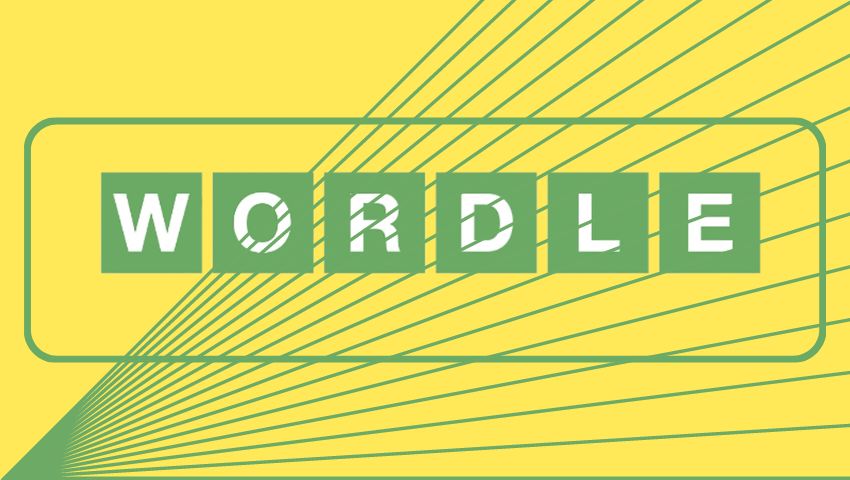Wordle Türkçe-TR 29 Ağustos Cevap Ne? 29 Ağustos Wordle Günün Kelimesi!

Her gün merakla beklenen yeni kelime için Wordle online oyunu Türkçe-TR formatı ile ülkemizde oynanmaya devam etmekte. 29 Ağustos Wordle Günün Kelimesi merak edenler için bugün ki yani 29 Ağustos Wordle tr Cevap Ne? Günde sadece bir kez oynanabilen Wordle Türkçe-TR Bugünkü Kelime Ne? Gelin birlikte Wordle TR 29 Ağustos Günün Kelimesi öğrenelim…
Wordle Türkçe-TR 29 Ağustos Cevap Ne?

Tüm dünyada bir anda popüler olarak oynanmaya başlayan ve sosyal medyada, bulunan kelime sonrası ekran görüntüleri paylaşılmaya başlanan oyun, Türkiye’ de Wordle Türkçe/TR formatıyla popüler hale geldi. Günlük olarak oynanabilen Wordle Türkçe Günün Kelimesi her gün değişmekte. Wordle oyunundaki oyuncular her gün yeni bir kelimeyi bulmaya çalışıyor. Wordle TR günün kelimesi 29 Ağustos içeriğimizde bulabilirsiniz…
👉29 Ağustos Wordle günün cevabı=>MEDAR
- 28 Ağustos Wordle kelimesi=>SERİK
- 27 Ağustos Wordle kelimesi=>MADDE
- 26 Ağustos Wordle kelimesi=>TAVLI
- 25 Ağustos Wordle kelimesi=>UZAMA
- 24 Ağustos Wordle kelimesi=>MAKET
- 23 Ağustos Wordle kelimesi=>KESAT
- 22 Ağustos Wordle kelimesi=>ETKİN
- 21 Ağustos Wordle kelimesi=>ÇAYLI
- 20 Ağustos Wordle kelimesi=>SATEN
- 19 Ağustos Wordle kelimesi=>GIDIK
- 18 Ağustos Wordle kelimesi=>HİZAN
- 17 Ağustos Wordle kelimesi=>DİPLİ
- 16 Ağustos Wordle kelimesi=>SEKİL
- 15 Ağustos Wordle kelimesi=>TARİZ
- 14 Ağustos Wordle kelimesi=>SORUM
- 13 Ağustos Wordle kelimesi=>PUSMA
- 12 Ağustos Wordle kelimesi=>KİSVE
- 11 Ağustos Wordle kelimesi=>SİDİK
- 10 Ağustos Wordle kelimesi=>BEKÇİ
- 9 Ağustos Wordle kelimesi=>SAVAK
- 8 Ağustos Wordle kelimesi=>ROBOT
- 7 Ağustos Wordle kelimesi=>LAÇİN
- 6 Ağustos Wordle kelimesi=>VİRAL
- 5 Ağustos Wordle kelimesi=>BİNDİ
- 4 Ağustos Wordle kelimesi=> BİRAZ
- 3 Ağustos Wordle kelimesi=> HONAZ
- 2 Ağustos Wordle kelimesi=> BURGU
- 1 Ağustos Wordle kelimesi=> ŞERPA
- 31 Temmuz Wordle kelimesi=> KOLLU
- 30 Temmuz Wordle kelimesi=> DOĞAL
- 29 Temmuz Wordle kelimesi=> FİTİN
- 28 Temmuz Wordle kelimesi=> KISIŞ
- 27 Temmuz Wordle kelimesi=> HAZCI
- 26 Temmuz Wordle kelimesi=> SÜZÜK
- 25 Temmuz Wordle kelimesi=> MUTLU
- 24 Temmuz Wordle kelimesi=> AİDAT
- 23 Temmuz Wordle kelimesi=> GOLCÜ
- 22 Temmuz Wordle kelimesi=> DÜĞÜM
- 21 Temmuz Wordle kelimesi=> DUHUL
- 20 Temmuz Wordle kelimesi=> BARIŞ
- 19 Temmuz Wordle kelimesi=> DELTA
- 18 Temmuz Wordle kelimesi=> DİRİM
- 17 Temmuz Wordle kelimesi=> TORNA
- 16 Temmuz Wordle kelimesi=> GİRİŞ
- 15 Temmuz Wordle kelimesi=> İYİCE
- 14 Temmuz Wordle kelimesi=> SİZCE
- 13 Temmuz Wordle kelimesi=> İHRAM
- 12 Temmuz Wordle kelimesi=> MÜHÜR
- 11 Temmuz Wordle kelimesi=> DOMUZ
- 10 Temmuz Wordle kelimesi=> BETER
- 9 Temmuz Wordle kelimesi=> ZORLA
- 8 Temmuz Wordle kelimesi=>UMMAK
- 7 Temmuz Wordle kelimesi=>ETSİZ
- 6 Temmuz Wordle kelimesi=>HARAM
- 5 Temmuz Wordle kelimesi=>EŞARP
- 4 Temmuz Wordle kelimesi=>SOMON
- 3 Temmuz Wordle kelimesi=> ARDIL
- 2 Temmuz Wordle kelimesi=> SİNSİ
- 1 Temmuz Wordle kelimesi=> MISRA
- 30 Haziran Wordle kelimesi=> TUĞRA
- 29 Haziran Wordle kelimesi=> İSPAT
- 28 Haziran Wordle kelimesi=> ZALİM
- 27 Haziran Wordle kelimesi=> KATIR
- 26 Haziran Wordle kelimesi=> ANCAK
- 25 Haziran Wordle kelimesi=> HAPŞU
- 24 Haziran Wordle kelimesi=> ARACI
- 23 Haziran Wordle kelimesi=> HIRBO
- 22 Haziran Wordle kelimesi=> TOPAÇ
- 21 Haziran Wordle kelimesi=> BAREM
- 20 Haziran Wordle kelimesi=> KARGO
- 19 Haziran Wordle kelimesi=> GÜDÜK
- 18 Haziran Wordle kelimesi=> İŞLEV
- 17 Haziran Wordle kelimesi=> TOPUK
- 16 Haziran Wordle kelimesi=> KESME
- 15 Haziran Wordle kelimesi=> DESEN
- 14 Haziran Wordle kelimesi=>SELİM
- 13 Haziran Wordle kelimesi=>İPLİK
- 12 Haziran Wordle kelimesi=>STATÜ
- 11 Haziran Wordle kelimesi=>BÜLUĞ
- 10 Haziran Wordle kelimesi=>İMSAK
- 9 Haziran Wordle kelimesi=>ŞUBAT
- 8 Haziran Wordle kelimesi=>YEMİN
- 7 Haziran Wordle kelimesi=>VAPUR
- 6 Haziran Wordle kelimesi=>SONDA
- 5 Haziran Wordle kelimesi=>ÖNDER
- 4 Haziran Wordle kelimesi=>FİNAL
- 3 Haziran Wordle kelimesi=>BAŞÇI
- 2 Haziran Wordle kelimesi=>SIHHİ
- 1 Haziran Wordle kelimesi=>ZEHİR
- 31 Mayıs Wordle kelimesi=>KAHVE
- 30 Mayıs Wordle kelimesi=>ALACA
- 29 Mayıs Wordle kelimesi=>TOKUZ
- 28 Mayıs Wordle kelimesi=>CADDE
- 27 Mayıs Wordle kelimesi=>SAHAF
- 26 Mayıs Wordle kelimesi=>KOPYA
- 25 Mayıs Wordle kelimesi=>ÖLMÜŞ
- 24 Mayıs Wordle kelimesi=>EVRİM
- 23 Mayıs Wordle kelimesi=>İSTİF
- 22 Mayıs Wordle kelimesi=>PİZZA
- 21 Mayıs Wordle kelimesi=>MUZİP
- 20 Mayıs Wordle kelimesi=>YAVAN
- 19 Mayıs Wordle kelimesi=>CEREN
- 18 Mayıs Wordle kelimesi=>TUZCU
- 17 Mayıs Wordle kelimesi=>PELİT
- 16 Mayıs Wordle kelimesi=>KALAY
- 15 Mayıs Wordle kelimesi=>DAVAR
- 14 Mayıs Wordle kelimesi=>AVARE
- 13 Mayıs Wordle kelimesi=> SAUNA
- 12 Mayıs Wordle kelimesi=>BAŞAK
- 11 Mayıs Wordle kelimesi=>DÜZEN
- 10 Mayıs Wordle kelimesi=>İNANÇ
- 9 Mayıs Wordle kelimesi=>SERAP
- 8 Mayıs Wordle kelimesi=>GÜDÜM
- 7 Mayıs Wordle kelimesi=>ÇELLO
- 6 Mayıs Wordle kelimesi=>UYRUK
- 5 Mayıs Wordle kelimesi=>DİĞER
- 4 Mayıs Wordle kelimesi=>TUZLA
- 3 Mayıs Wordle kelimesi=>DÖŞEK
- 2 Mayıs Wordle kelimesi=>SÜTLÜ
- 1 Mayıs Wordle kelimesi=>KOKOŞ
Wordle Kelime Oyunu Nasıl Oynanır?
Son zamanların en popüler söz oyunlarından olan Wordle, Amerikalı Josh Wardle’nin yaptığı bir oyundur ve ülkemizde çok fazla oynanır hale gelmiştir. Wordle kelime oyunu 2021’in son aylarında çıkmıştır. Oyun 5 harfli bir kelime tahmin etme oyunudur. Oyunda maksimum 6 hakkınız oluyor ve 5 harfli kelimeyi sırasıyla tahmin etmeye çalışıyorsunuz. Oyunu sadece web site üzerinden oynayabilirsiniz.

- – ilk olarak “Haber” tahmini yaptık. Hiç renk yanmadı. Devam edelim.
- – İkinci tahminimiz “Kolye” olsun. Yine bilemedik.
- – Üçünü tahminimizi “Vakit” olarak yapalım. Evet İ harfini bildik. V harfini de bildik ama yeri yanlış.
- – Diğer tahminimiz “Ceviz” oldu. Son 3 harfi bilmiş olduk. Yani kelimemiz –VİZ şeklinde olacaktır. Son 3 harfi VİZ ile bitiyor.
- – O zaman son tahminimiz gelsin: DÖVİZ…
Wordle’ da oyuncuları yönlendirmek için gri, sarı ve yeşil renkler kullanılmakta. Gri kutular, o harfin doğru kelimede hiç olmadığı anlamına geliyor. Aslında oyunun en kritik ve çekici kılan kısmı da burada karşımıza çıkıyor. Tahmin ettiğiniz kelime içindeki harfler, doğru yerdeyse kutucuk yeşil yanıyor. Doğru yerde kullanılmayan harfler ise sarı renge değişiyor.




